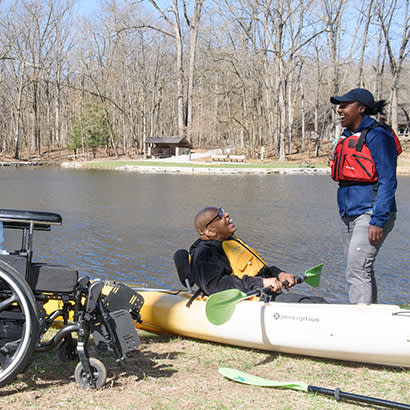
For an enhanced digital experience, read this story in the ezine.
All three of NRPA’s pillars — Health and Wellness, Equity, and Conservation — are a reflection of how parks and recreation are central to many of the challenges communities face, as well as to potential solutions.
Our equity work is built on the idea that difference meets at the playground. To better support members in seeing difference as a strength, we are working to create opportunities for professionals to learn and practice. This is the reason why we are moving from using “Diversity, Equity and Inclusion” (DEI) as a descriptor to “Equity in Practice.” Similarly, our Health and Wellness pillar is built on the idea that the field of parks and recreation is a key part of the public health system, and to better address individual and community health, we work to support agencies in their practice as Community Wellness Hubs — trusted gathering places that connect community members to programs, services and spaces to improve health outcomes. To advance equity in all its forms and create change, we have to do more than learn — we also have to practice and take action.
The desire from the field for practice and action was reflected in the Diversity, Equity and Inclusion in Parks and Recreation report released in 2021. Respondents to the survey discussed the need for trusted resources, tools and templates to help agencies not only learn what DEI in parks and recreation can look like, but also how to apply that work in what they do, whether it be administration, programs or maintenance.
Also in 2021, NRPA released Elevating Health Equity Through Parks and Recreation: A Framework for Action. Authored by Epic Health Solutions, this resource is designed to help professionals be more intentional as they advance health equity, providing them with opportunities to apply a racial equity lens when designing, implementing and evaluating programs and services, and when developing infrastructure, maintenance and operations plans.
Looking back on this resource a year later, I’d like to highlight and focus on the resources, tools, templates and new videos provided in the framework — especially the self-assessment, agency assessment and committing to the call — as an offering to individuals and agencies that are looking to “just get started.”
Getting Started
In their simplest form, organizations and agencies are groups of people. Starting at the individual level helps people to see why this work is important and what it has to do with them. Providing time to reflect on and work through their beliefs, values and life experiences is a good place to start. Part one of the resource, “Self-Assessment,” provides worksheets that challenge individual thinking, providing an opportunity for professionals to consider their identities, beliefs, actions and experiences, and the ways those impact their work and interactions.
Assessing your agency is another place to start. It can give you a solid idea of strengths and challenges, which can help you to prioritize what to do or where to start. Part two of the resource, “Agency Assessment,” looks at your agency’s culture. Worksheets include examining your local park and recreation history; defining what justice, equity, diversity and inclusion mean in your organization and if your agency’s policies and practices are in line with those beliefs; identifying the communities you serve and how your programs and services reflect them; policy and systems change; and evaluation and impact.
Part four of the resource, “Committing to the Call,” asks you what success looks like for your equity work, the steps and resources needed, and how to hold your agency accountable. These worksheets provide a completed example and a template to assist in creating a plan of action that builds on your assessment of agency culture, programs, services and facilities.
It’s important to remember that none of us can do “all of the things” or address every inequity, issue or challenge identified in the assessment. However, you can do something and start somewhere for a quick win. Do you have the support to start with the hiring process? Or a culture of inclusion and gratitude? Do you have a new community coming to your center that requires you to adjust a few policies and practices?
What is most important is that you start somewhere. I hope these tools and resources get you started.
Autumn Saxton-Ross, Ph.D., is Vice President of Education and Chief Equity Officer at NRPA.

